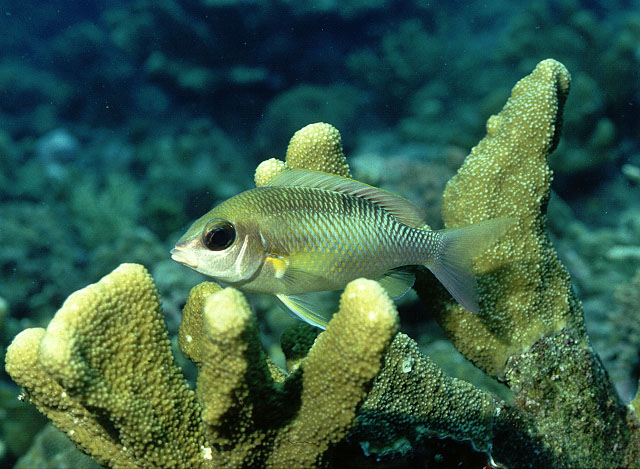| Nemipteridae (Threadfin breams, Whiptail breams) |
| 28 cm TL (male/unsexed) |
|
reef-associated; marine; depth range 2 - 25 m |
| Western Pacific: South China Sea to Vanuatu and northwestern Australia. |
|
Dorsal spines (total): 10-10; Dorsal soft rays (total): 9-9; Anal spines: 3-3; Anal soft rays: 7-7. Head scales reaching to or almost to posterior nostrils. Lower limb of preopercle scaly. Antrorse (forward-directed) suborbital spine absent. Pelvic fins long, reaching almost to or beyond level of origin of anal fin. Color: Upper body olive, white below. 2 pearly white stripes on snout in front of eyes. Lower lobe of caudal fin reddish. Juveniles white, with a narrow black stripe along back (only on some specimens) and black midlateral stripe. Some with a yellowish ventral surface. Presence of a black spot between first four dorsal spines. Some color variation between Indian and Pacific populations: juveniles lack yellow stripe in the Indian Ocean population and adults show a contrasting dark back compared to Pacific form (Ref. 48635). |
| Found on sand bottoms close to reefs. Feed on crustaceans, polychaete worms, mollusks and small fishes (Ref. 3810, 9785). Juveniles may be Batesian mimics of poison-fang blennies, Meiacanthus spp. (M. geminatus and M. vittatus) (Ref. 37816, 90102). It is parasitised by the monogenean Anoplodiscus hutsonae on the pectoral fins and body surface (Ref. 124057). |
|
Least Concern (LC); Date assessed: 03 March 2015 Ref. (130435)
|
| harmless |
Source and more info: www.fishbase.org. For personal, classroom, and other internal use only. Not for publication.
